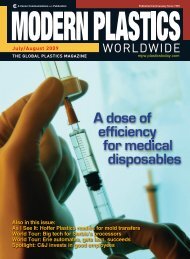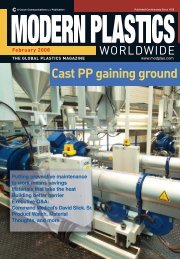amidiq - dae uptlax
amidiq - dae uptlax
amidiq - dae uptlax
You also want an ePaper? Increase the reach of your titles
YUMPU automatically turns print PDFs into web optimized ePapers that Google loves.
J. Romero-González et al. / Revista Mexicana de Ingeniería Química Vol. 6, No. 3 (2007) 295-300<br />
2.4. Time dependence for Pb(II) sorption<br />
The time dependence experiments were<br />
performed in a similar fashion to that previously<br />
reported by Gardea-Torresdey et al. (1998). A 250<br />
mg sample of grounded biomass was washed in<br />
deionizated water in order to remove any metal ions<br />
or soluble materials that might interfere with Pb (II)<br />
adsorption. The biomass was then re-suspended in 50<br />
ml of deionizated water to obtain a final biomass<br />
concentration of 5 mg/ml. The biomass suspension<br />
was then adjusted to the appropriate optimal pH,<br />
determined from the pH profile studies: pH 5 for Pb<br />
(II). Aliquots of 4 ml of 0.3 mM metal solution (Pb<br />
(II) at pH 5) were added to the 42 tubes containing<br />
biomass pellets and allowed to react for: 5, 10, 15,<br />
30, 60, 90 and 120 min. At each time interval the test<br />
tubes were centrifuged and the supernatants were<br />
discarded. Three additional tubes containing just Pb<br />
(II) solution were maintained as control for each time<br />
period. The tubes, containing approximately 20 mg<br />
of biomass and 4 ml of 0.3 mM metal solution and<br />
the respective controls, were then equilibrated at the<br />
different time intervals and then centrifuged at 3,000<br />
rpm for 5 min. The supernatants from all tubes were<br />
separated from the pellets and were transferred to<br />
clean test tubes for their posterior analysis of<br />
concentration Pb (II) using FAAS.<br />
2.5. Adsorption capacity<br />
The adsorption capacity of Agave tequilana<br />
Weber for Pb removal was determined with the<br />
isotherms experiments. These were performed as<br />
previously published (Romero-Gonzalez et al.,<br />
2005b). A sample of 2.0 grams was taken from the<br />
ground Agave Azul leaves biomass, washed once<br />
with HCl 0.01M and twice with deionized water.<br />
After each washing, the biomass was centrifuged for<br />
5 min at 3000 rpm (Fisher Scientific Marathon 6K).<br />
The biomass was suspended in deionized water to<br />
have a final concentration of 5 mg of biomass per ml<br />
with the pH previously adjusted to 5.0. Two ml of<br />
the biomass solution were placed in 5-ml test tubes,<br />
centrifuged, and the supernatants were discarded.<br />
Each tube was used at 0.0, 9.6, 19, 29, 38, 48, 58, 67<br />
and 77 x 10 -5 mol of Pb(II) · dm -3 (three replicates<br />
per Pb (II) concentration, adjusted to pH 5.0).<br />
Besides, a fourth tube containing only Pb (II)<br />
solution (no biomass) was set as a control. Aliquots<br />
of 2 ml of the Pb (II) solutions were transferred to<br />
the respective labeled biomass tubes. The tubes and<br />
controls were allowed to equilibrate for 60 min at<br />
room temperature (25 ± 2 o C), centrifuged, and the<br />
supernatants were saved for metal quantification.<br />
3. Results and Discussion.<br />
3.1. pH profile<br />
The percentage binding of Pb (II) to Agave<br />
azul biomass is shown in Table 1. As one can see in<br />
this table, the binding of Pb (II) is pH dependent.<br />
First, the amount of Pb (II) bound to Agave azul<br />
biomass increased as pH increased from pH 1 to 5.<br />
At pH 5, the biomass showed a maximum binding of<br />
93% of the Pb (II) present in the solution. On the<br />
other hand, the binding of Pb (II) to Agave azul<br />
biomass decreased as pH increased above 5. This<br />
trend in pH dependence suggests that the binding of<br />
the metals to the biomass is through an ion exchange<br />
mechanism. Solution pH influences both cell surface<br />
metal binding sites and metal chemistry in water. At<br />
low pH, cell wall ligands were closely associated<br />
with the hydronium ions H3O + and restricted the<br />
approach of metal cations as a result of the repulsive<br />
force. As the pH increased, more ligands such as<br />
carboxyl, phosphate and amino groups would be<br />
exposed and carried negative charges with<br />
subsequent attraction of metallic ions with positive<br />
charge and biosorption onto the cell surface<br />
(Romero-Gonzalez et al., 2005a).<br />
Table 1. pH profile for Pb(II) binding by Agave<br />
tequilana Weber biomass.<br />
pH % metal bound<br />
1 42<br />
2 74<br />
3 76<br />
4 86<br />
5 93<br />
6 76<br />
7 65<br />
3.2. Adsorption kinetic parameters<br />
The results of Pb (II) adsorption by Agave<br />
azul biomass, from the time dependence studies are<br />
shown in Table 2. These results indicate that the<br />
process of Pb (II) adsorption by Agave azul is timedependent.<br />
The trend in Pb (II) adsorption suggests<br />
that the binding of this ion may be through<br />
interactions with functional groups such as carboxyl<br />
or hydroxyl groups located on the surface of Agave<br />
azul biomass.<br />
In order to investigate the mechanism of<br />
Pb(II) biosorption, the experimental data of the time<br />
dependence studies were utilized in the first-order<br />
and pseudo second-order kinetic models. The firstorder<br />
rate expression of Lagergren based on solid<br />
adsorption capacity is generally expressed as follows<br />
(Ho et al., 1996):<br />
dq / dt = K´ ad ( qe − q)<br />
(1)<br />
where qe is the amounts of solute adsorbed at<br />
equilibrium per weight of adsorbent (mg/g), q the<br />
297









